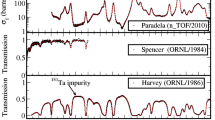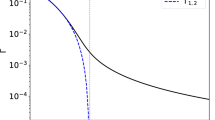Abstract
A correlation between the intrinsic fusion barriers as a function of the incident energy and the observed excitation functions of fusion-evaporation residues has been obtained by investigating eleven arbitrarily chosen heavy-ion fusion-evaporation reactions forming compound nuclei in the heavy and superheavy mass region. The intrinsic fusion barrier for a given heavy-ion reaction and incident energy is calculated from the fragmentation potential of the compound nucleus at its critical angular momentum. The fragmentation potentials are calculated by assuming that the fragments are spherical in shape for the reactions leading to the formation of compound nuclei in the heavy mass region and deformed and oriented in the superheavy mass region. It is found that the incident energy for which the intrinsic fusion barrier is minimum or close to the minimum value corresponds to the maximum of the measured fusion-evaporation residue cross-section. This calculated energy can be a suitable energy for synthesizing new elements; here, it is done for Z = 119 and is in good agreement with the estimates available in the literature.






Similar content being viewed by others
References
G.G. Adamian, N.V. Antonenko, W. Scheid, Nucl. Phys. A 618, 176–198 (1997)
G.G. Adamian, N.V. Antonenko, W. Scheid, V.V. Volkov, Nucl. Phys. A 633, 409–420 (1998)
E.A. Cherepanov, Pramana -. J. Phys. 53, 619–630 (1999)
G.G. Adamian, N.V. Antonenko, W. Scheid, Nucl. Phys. A 678, 24–38 (2000)
G. Fazio, G. Giardina, A. Lamberto et al., Eur. Phys. J. A 19, 89–104 (2004)
A. Nasirov, G. Giardina, G. Mandaglio et al., J. Phys.: Conf. Ser. 282, 012010 (2011)
N.V. Antonenko, E.A. Cherepanov, A.K. Nasirov, V.P. Permjakov, V.V. Volkov, Phys. Lett. B 319, 425–430 (1993)
G. Giardina, S. Hofmann, A.I. Muminov, A.K. Nasirov, Eur. Phys. J. A 8, 205 (2000)
D. S. Verma, Kushmakshi, M. Manhas, J. Nucl. Phy. Mat. Sci. Rad. A. 9, 145-149 (2022)
A. Nasirov, A. Fukushima, Y. Toyoshima et al., Nucl. Phys. A 759, 342–369 (2005)
A. Nasirov, K. Kim, G. Mandaglio, G. Giardina, A. Muminov, Y. Kim, Eur. Phys. J. A 49, 147 (2013)
D.A. Mayorov, T.A. Werke, M.C. Alfonso et al., Phys. Rev. C 90, 024602 (2014)
T.A. Werke, D.A. Mayorov, M.C. Alfonso et al., Phys. Rev. C 92, 054617 (2015)
K. Satou, H. Ikezoe, S. Mitsuoka et al., Phys. Rev. C 73, 034609 (2006)
Yu. Ts. Oganessian, V.K. Utyonkov, Y.V. Lobanov, et al., Nucl. Phys. A 734, 109-123 (2004)
Yu. Ts. Oganessian, F.S. Abdullin, C. Alexander, et al., J. Phys.: Conf. Ser. 580, 012038 (2015)
Yu. Ts. Oganessian and V.K. Utyonkov, Rep. Prog. Phys. 78, 036301 (2015)
L. Zhu, W. Xie, F. Zhang, Phys. Rev. C 89, 024615 (2014)
M. Tanaka, P. Brionnet, M. Du et al., J. Phys. Soc. Jpn. 91, 084201 (2022)
J. Maruhn, W. Greiner, Phys. Rev. Lett. 32, 548 (1974)
R.K. Gupta, W. Scheid, W. Greiner, Phys. Rev. Lett. 35, 353 (1975)
A. Sǎndulescu, R.K. Gupta, W. Scheid, W. Greiner, Phys. Lett. B 60(3), 225–228 (1976)
R.K. Gupta, M. Balasubramaniam, R. Kumar, D. Singh, C. Beck, W. Greiner, Phys. Rev. C 71, 014601 (2005)
N.J. Davidson, S.S. Hsiao, J. Markrama et al., Phys. Lett. B 315, 12–16 (1993)
P.A. Seeger, Nucl. Phy. 25, 1–135 (1961)
A.S. Jensen, J. Damgaard, Nucl. Phys. A 203, 578 (1973)
W.D. Myers, W.J. Swiatecki, Nucl. Phy. 81, 1–60 (1966)
M. Wang, G. Audi, F.G. Kondev, Chin. Phys. C 41, 030003 (2017)
P. Moller, A. J. Sierk, T. Ichikawa and H. Sagawa, At. Data Nucl. Data tables 109–110, 2016
D. S. Verma and Kushmakshi, J. Radioanal. Nucl. Chem. 322, 139-146 (2019)
J. Blocki, J. Randrup, W.J. Swiatecki, C.F. Tsang, Ann. Phys. 105, 427–462 (1977)
A.J. Baltz, B.F. Bayman, Phys. Rev. C 26, 1969–1983 (1982)
G. Royer, J. Mignen, J. Phys. G: Nucl. Part. Phys. 18, 1781–1792 (1992)
R.K. Gupta, N. Singh, M. Manhas, Phys. Rev. C 70, 034608 (2004)
C.Y. Wong, Phys. Rev. Lett. 31, 766–769 (1973)
W.D. Myers, Nucl. Phys. A 204, 465–484 (1973)
A. Nasirov, G. Giardina, G. Mandaglio et al., J. Phys.: Conf. Ser. 515, 012015 (2014)
C. Cabot, H. Gauvin, Y.L. Beyec et al., Nucl. Phys. A 427, 173–185 (1984)
Acknowledgements
The authors are thankful to the Central University of Himachal Pradesh for providing the necessary facility for completing this work.
Author information
Authors and Affiliations
Corresponding author
Ethics declarations
Conflict of Interest
The authors declare no competing interests.
Additional information
Publisher’s Note
Springer Nature remains neutral with regard to jurisdictional claims in published maps and institutional affiliations.
Rights and permissions
Springer Nature or its licensor (e.g. a society or other partner) holds exclusive rights to this article under a publishing agreement with the author(s) or other rightsholder(s); author self-archiving of the accepted manuscript version of this article is solely governed by the terms of such publishing agreement and applicable law.
About this article
Cite this article
Verma, D.S., Vivek & Chauhan, P. Correlation Between the Intrinsic Fusion Barriers and Observed Excitation Functions of Evaporation Residue. Braz J Phys 53, 109 (2023). https://doi.org/10.1007/s13538-023-01319-4
Received:
Accepted:
Published:
DOI: https://doi.org/10.1007/s13538-023-01319-4




